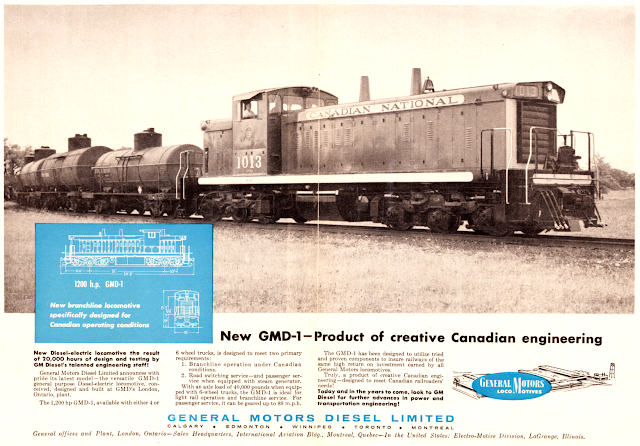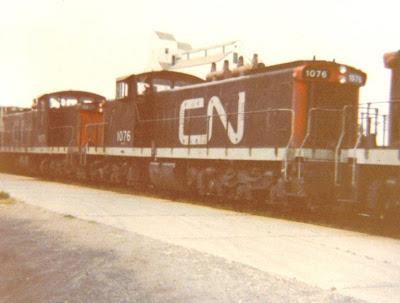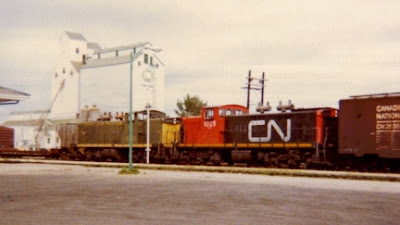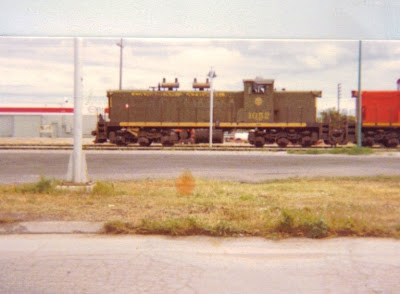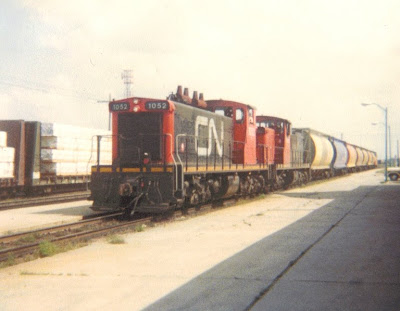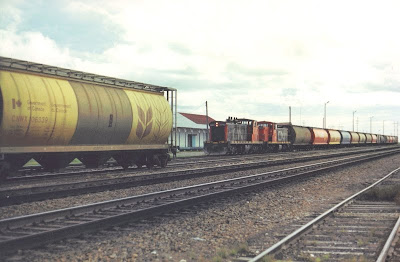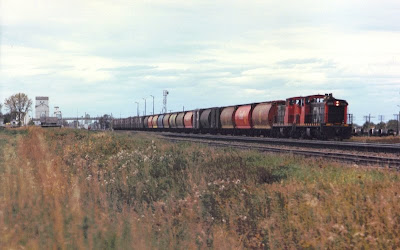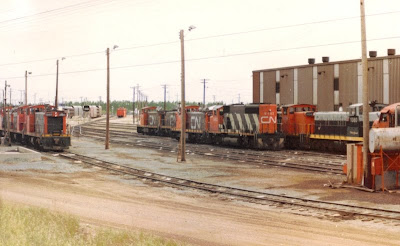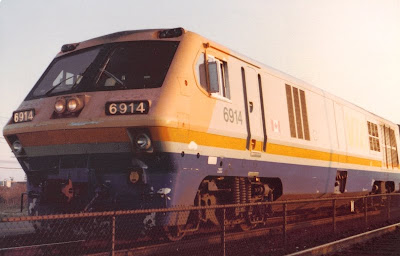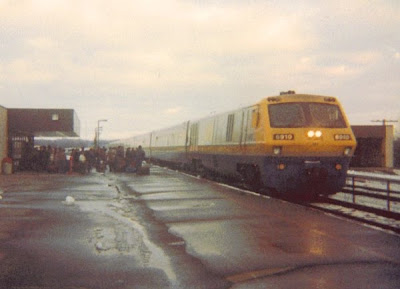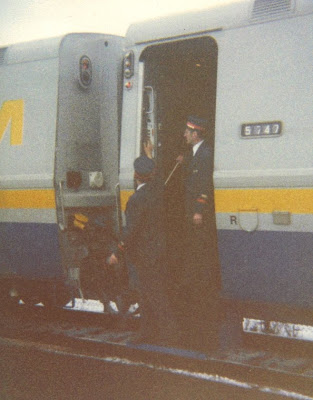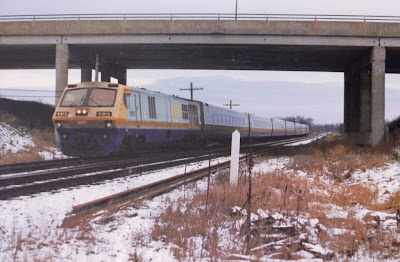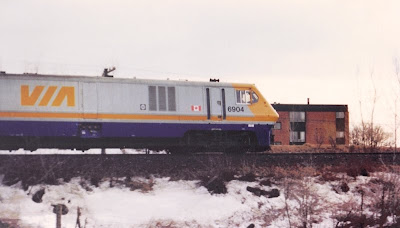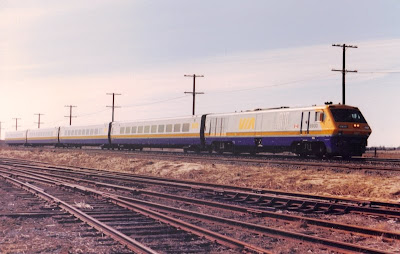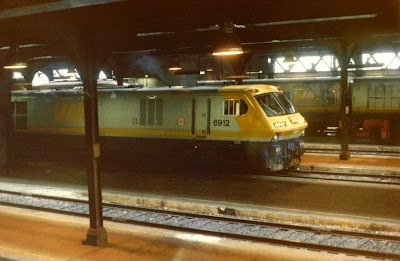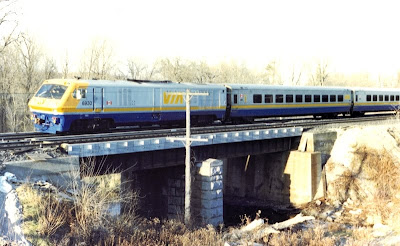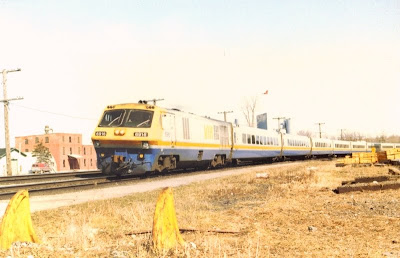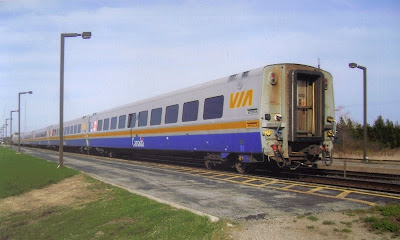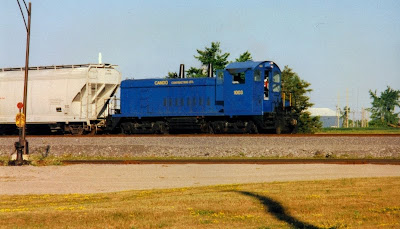 CN's Millhaven Spur has long been an industry receiving covered hoppers and tank cars from the Kingston Sub. This post contains car sightings from 1997 to 2006. I have few car sightings at the spur before 1997, though I did record a few boxcars in earlier years:
CN's Millhaven Spur has long been an industry receiving covered hoppers and tank cars from the Kingston Sub. This post contains car sightings from 1997 to 2006. I have few car sightings at the spur before 1997, though I did record a few boxcars in earlier years:- Oct 4/80 SAL 28059 (at Belleville)
- Mar 4/82 SAL 28625
- Sep/82 Seaboard Coast Line and Southern Railway boxcars such as SCL 828080, 828066 and SR 16164, 16085
- Jun/83 SCL (Seaboard Air Line) 828132 and SR 16164, 16398
CCBX tank cars 4365 and 4380 were also at the plant in September 1982.
Here are some cars spotted at the plant in 1997-1998, including my afternoon on the Millhaven Spur in December 1997:
TANK CARS:
Grey: CGBX 4371, 4372, 4373, 4381, 4387, 4392, 4393.
Black: CGBX 4320, 4374, 4377, 4378, 4379, 4382, 4383, 4386, 4389, 4390, 4391, 5015, 5108, 5024; UTLX 25700, 40489, 43489, 70441
Blue: EOGX 4052, 4054, 4073, 4074, 4082, 4084, 4090, 4093, 4109, 4111, 4115, 4118, 4120, 4135, 4148, 4164, 4168, 4169, 4173; CELX 4253, 14220, 14233, 14241, 14250, 16230, 16240, 22110, 22148; ACFX 73390; UTLX 640898, 640912, 640913.
COVERED HOPPER CARS:
AMCX 5548, 5579, 6299, 206407, 206415, 206525, 206581; CELX 51064, 57286, 57307, 59808, 59822, 59828, 59841, 59891, 59898.
 In 1999-2000:
In 1999-2000:TANK CARS:
Grey: CELX 14229, 15224, 15240, 15249, 15251.
Blue: EOGX 4041, 4042, 4055, 4059, 4063, 4085, 4094, 4096, 4108, 4115, 4116, 4128, 4132, 4143, 4158, 4160, 4171; UTLX 640414(lettered EQ) and 640427 (above), 640326, 640429, 640431, 640901, 640905, 640911, 640914, 641678, 642447, 642448, 642451, 642453, 642459, 642472; RAIX 6488; CELX 4203, 4205, 4223, 14217, 14250, 14255, 15248; CCBX 400142, 400144, 400148, 400149, 400155, 400157, 400158, 400159, 400161, 400163, 400166, 400172, 400174, 400175, 400183, 400185, 400195, 400197, 400207, 400209.
COVERED HOPPER CARS:
AMCX 5222, 5224, 5479, 5555, 5575, 6255, "green belt" 5370, 206336, 206496; ACFX 67445; CELX 51284, 57224, 57275, NRLX 58066.
New blue CCBX tank cars were in use from 1999-2001, such as CCBX 400141 at Belleville:
 In 2001:
In 2001:TANK CARS:
EOGX 4059, 4084, 4106, 4110, 4116, 4127, 4136, 4170; CCBX 400140, 400141, 400147, 400162, 400165, 400168, 400171, 400201, 400212.
COVERED HOPPER CARS:
AMCX 5468, 5554, 5688, 6337, 106101, 106233, 206280, 206283, 206290, 206318, 206522; CELX 51011, 51160, 51287, 51331, 51393, 51427, 57228, 57246, 57304, 59789, 59844, 59888; FURX 870006, 870044, 870090, 870098; GPLX 1283, 1306, 1318; NAHX 570402; NRLX 58046, 58119, 58121.
With the takeover of Celanese by KoSa in 2002, new green tank cars started arriving with ethylene glycol, such as PROX 75333 and TILX 262169 at Belleville in 2006:

 In 2002:
In 2002:TANK CARS:
Green: PROX 75175, 75245, 75254, 75317, 75328, 75334, 75410, 75419.
In 2006:
TANK CARS:
Green: PROX 75333; TILX 261246, 246159, 262169.
GPLX 1349 is an example of the plethora of leased plastic covered hoppers loaded at the plant. It's shown at Belleville yard, where cars for Millhaven are set out for, and lifted from Train 519:
 Cando 1002-1003 happily drill covered hoppers in 2002 along Jim Snow Drive. The CHiP resin loading shed is shown at extreme right. Unfortunately, the plant would close in 2009.
Cando 1002-1003 happily drill covered hoppers in 2002 along Jim Snow Drive. The CHiP resin loading shed is shown at extreme right. Unfortunately, the plant would close in 2009. Meanwhile, across Jim Snow Drive, Lafarge's asphalt operation had funnel-flow OptiMiser tank cars arriving on its two unloading tracks. UTLX 664857 is shown on the Cataraqui Spur in March 2004, before the new Millhaven facility opened. Its product is being steam-heated prior to unloading.
Meanwhile, across Jim Snow Drive, Lafarge's asphalt operation had funnel-flow OptiMiser tank cars arriving on its two unloading tracks. UTLX 664857 is shown on the Cataraqui Spur in March 2004, before the new Millhaven facility opened. Its product is being steam-heated prior to unloading. Realizing this is a post is the work of a rolling stock fanatic, if you made it this far you are likely a rolling stock fanatic yourself. Although the plant received a limited number of car types, the variety of reporting marks, paint schemes, and car specifications make the plant an interesting study for rolling stock fans. In fact, the cars often seemed so ubiquitous to me that I didn't always note car information, assuming the cars would always "be there". Not any more. Lesson learned.
Realizing this is a post is the work of a rolling stock fanatic, if you made it this far you are likely a rolling stock fanatic yourself. Although the plant received a limited number of car types, the variety of reporting marks, paint schemes, and car specifications make the plant an interesting study for rolling stock fans. In fact, the cars often seemed so ubiquitous to me that I didn't always note car information, assuming the cars would always "be there". Not any more. Lesson learned.Running extra...
Tonight on TLC's Hoarders: Buried Alive, a cautionary tale of a "railroadist" whose house became full of collected train memorabilia and other less important junk. During filming, a package arrives with what looked like a semaphore motor. Clearly, someone was sending him a signal.
A CN non-DPU eastbound freight this afternoon included a healthy cut of coil steel cars, likely heading for the Port of Montreal.
Having survived Black Friday in Syracuse, I celebrated life by visiting Barnes & Noble and Borders, with the latter having a much better selection of railway books. Mall benches provided excellent opportunities to catch up on a small stack of Railfan and Trains magazines.


